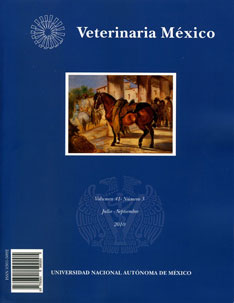Body composition in Pelibuey lambs in terms of feed energy concentration and slaughter weight
Main Article Content
Abstract
With the aim to study the effects of dietary energy and the slaughter weight on the carcass yield and characteristics of Pelibuey male lambs, the regional structure and tissue composition of 32 half carcasses, as well as the deposition pattern of visceral fat and its unsaturated fatty acid degree was assessed. The animals were fed two diets containing the same amount of crude protein (14.1%), but different energy density, diet I (D-I): 2.60 and diet II (D-II): 2.85 Mcal ME/kg DM. Lambs were slaughtered at 30, 37, 44 and 51 kg body weight. The data were analyzed on a completely randomized design with a factorial 2 × 4 arrangement. The commercial yield (%) differed (P ≤ 0.05) between diets (DI: 46.2 and D-II: 49.3) and between slaughter weights, increasing as the body weight increased. Neither diet nor the slaughter weight affected the carcass cuts; the piece that represented the highest percentage was the thorax (32.3%), followed by the leg (31.2%), shoulder (17.6%), abdomen (12.3%) and neck (6.7%). The D-II resulted in greater proportion of muscle (65.9%) than the DI (64.7%): as the slaughter weight increased so the fat did at the expense of bone and muscle. The energy density of the diet led to differences (P ≤ 0.05) in the amount of visceral fat (D-I: 5.8 ± 0.7 and D-II 7.0 ± 0.8), in the degree of unsaturated fatty acids (D-I: 39.2 ± 2.6 and D-II: 44.9 ± 2.8) and its deposition pattern (D-I: 51.7 ± 0.9; 48.3 ± 0.6 and D-II: 46.7 ± 0.6; 53.3 ± 0.8, respective percentages to carcass and viscera).
Article Details
License

Veterinaria México OA by Facultad de Medicina Veterinaria y Zootecnia - Universidad Nacional Autónoma de México is licensed under a Creative Commons Attribution 4.0 International Licence.
Based on a work at http://www.revistas.unam.mx
- All articles in Veterinaria México OA re published under the Creative Commons Attribution 4.0 Unported (CC-BY 4.0). With this license, authors retain copyright but allow any user to share, copy, distribute, transmit, adapt and make commercial use of the work, without needing to provide additional permission as long as appropriate attribution is made to the original author or source.
- By using this license, all Veterinaria México OAarticles meet or exceed all funder and institutional requirements for being considered Open Access.
- Authors cannot use copyrighted material within their article unless that material has also been made available under a similarly liberal license.



